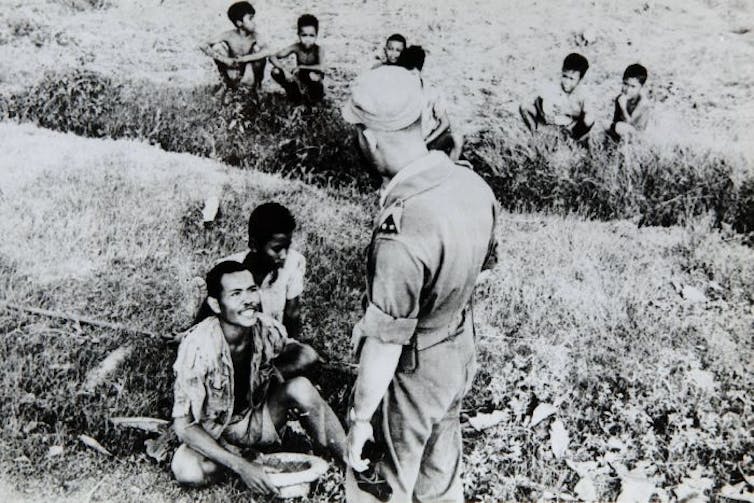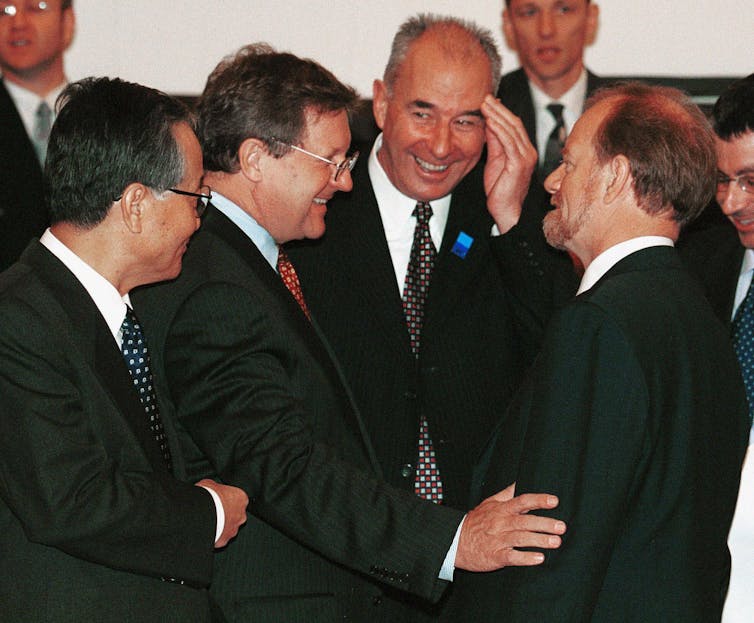The Canadian government has been taking flak lately for its arms sales.
Helicopters destined for the Philippines could be used for internal security in President Rodrigo Duterte’s harsh crackdowns, critics charge.
The $12-billion sale of light armoured vehicles to Saudi Arabia has also embroiled Justin Trudeau’s government in controversy.
In response, Foreign Affairs Minister Chrystia Freeland has pledged to review both deals, suggesting Canada is toughening up arms sales restrictions based on human rights grounds.

But how did Canada get into the international arms trade, anyway?
A look at the history of how Canada started selling weapons overseas following the Second World War reveals that, contrary to Freeland’s implication, Canada actually used to be much more restrictive on arms sales than it is today.
Canada has not made human rights any more central to its arms export policy than it was in the 1940s — in fact, it’s reduced oversight and the consideration of human rights issues when it comes to selling arms.
“Canada’s export controls are among the most rigorous in the world,” the government states.
It “strives to ensure that, among other policy goals, Canadian exports are not prejudicial to peace, security or stability in any region of the world or within any country.” In the post-Second World War period, Canada did not exactly “strive to ensure” these things — but it did say no when there was a risk of any of them happening.
How Canada got into the arms trade
Indeed, Canada entered the arms trade cautiously and carefully. After the Second World War, Ottawa was willing to pass surplus military equipment in Europe to allied governments.
But sales to less reliable countries, and those who might actually use the weapons, always required approval by the full cabinet. Prime Minister Mackenzie King noted that “great care should be taken with respect to all sales of weapons and supplies of war to foreign governments.”
The first test came in 1946, when cabinet agreed to sell six million 30-calibre cartridges and four million magazines to the Dutch army just as it was about to embark on a colonial war in Indonesia. But when the Dutch asked for 10,000 Sten machine guns for use in Indonesia, Canadian officials turned them down.
“We have no reason to believe that Canadian public opinion would support such a sale, nor would it be in the Canadian interest to make the sale,” according to one document from the day, now filed at Library and Archives Canada.
Why?

The guns would probably be employed in the “‘pacification’ of the native population,” exposing the government to “severe domestic and international criticism for supplying these arms” and potentially “prejudic(ing) for a long time our commercial relations with the Indonesians.”
Any further talk of helping the Netherlands — a close Canadian ally — was blocked by the Department of External Affairs
No to China
Cabinet did get to decide on a proposal in 1946 to sell warships to China, then a pro-American regime desperately fighting off the advances of Mao Zedong’s Chinese communists.
The Canadian government certainly sympathized with the Chinese Republicans. And the sale of 10 or 11 surplus Canadian frigates would have netted Canada some $2 million — the equivalent of $27 million in today’s money. Yet cabinet blocked the sale on the grounds that the ships “might be used in civil warfare.”
The same logic underpinned a Canadian decision to bar all military exports to Chinese Republicans in 1947.
In both cases, the logic was clear: Canada should sell arms only to close allies, and if there was any likelihood of use against civilians, no sale should be made.
Arming a dictatorship: Indonesia
By the 1970s, however, Canada had thrown early caution to the winds, becoming a keen seeker of arms exports. A recent analysis shows that Canada supplied $5.8 billion worth of arms over the past 25 years to countries classed as “dictatorships” by the human rights group Freedom House.
The example of arms sales to Indonesia curiously shows both a greater Canadian willingness to sell and the limits to that willingness.
Indonesia notoriously invaded the former Portuguese colony of East Timor in 1975, with more than 100,000 Timorese perishing under the subsequent military occupation. From 1975 to 1991, Canada nonetheless was willing to sell arms to Indonesia.
Writing in the 1980s, Timorese leader José Ramos Horta described Canadian “double standards” in scathing terms: “These weapons play an important role in the war in East Timor. But how does the Canadian government explain the weapons exports to Indonesia if Canadian law states that export permits should be issued only for ‘non-conflict’ areas? Simply by asserting that there is no armed conflict in East Timor – knowing that to be a lie.”
Yet there were limits.
In 1991, a massacre in East Timor prompted Barbara McDougall, foreign minister in Brian Mulroney’s Progressive Conservative government, to impose an arms embargo.
There was no suggestion that Canadian-made arms had been used in the massacre, but McDougall was taking no chances.
Arms sales to Indonesia resumed as Jean Chrétien’s government embraced Indonesia, but there was increasing dissent within the Department of Foreign Affairs about it.
“Any question of military sales to Indonesia, by definition, is a sensitive issue,” one divisional director wrote. After all, he noted acidly, “the Indonesian army is still killing people in East Timor.”
In September 1999, after extensive public pressure, foreign minister Lloyd Axworthy imposed an arms embargo as pro-Indonesia militia groups killed, forcibly relocated and terrorized the Timorese population. No evidence was required that Canadian-supplied weapons were being used against civilians. The government simply acted.

Bending away from justice
Some 80 years ago, British historian Herbert Butterfield criticized those who rewrite the past in order “to produce a story which is the ratification if not the glorification of the present.”
This “Whiggish” view of history insists that things get better over time, in a progressive arc leading to general improvement.
It’s this sense that Chrystia Freeland invokes when she promises to ban the sale of a weapon “if there were a substantial risk that it could be used to commit human rights violations” — and describes that as progress.
In actual fact, if previous debates on arms sales are anything to go by, Canada is less vigilant on human rights than it was in 1946, or even in 1999. It has some way to go before it approaches the standards that once prevailed.
The arc of Canadian arms sales is long, but it seems to bend away from, not towards, human rights.
The article was first published by The Conversation (http://www.theconversation.com) and is republished with permission granted to www.oasesnews.comAuthor:Associate Professor of History, Bishop's University
Credit link:https://theconversation.com/canadas-checkered-history-of-arms-sales-to-human-rights-violators-91559
The article was first published by The Conversation (http://www.theconversation.com) and is republished with permission granted to www.oasesnews.com


